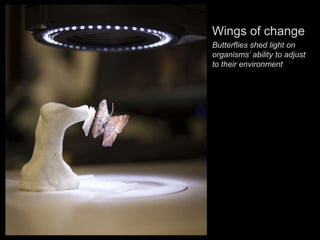
Wings of change
- 1. Wings of change Butterflies shed light on organisms’ ability to adjust to their environment
- 2. What does it take to thrive in a changing world? Being able to alter one’s developmental trajectory in response to the environment can be a big boon. But such “plasticity” may also come with a cost – such as lower reproductive rates. Improving our understanding of how organisms meet the demands of changing world is more important than ever today, as human actions create new and unusual habitats.
- 3. Emilie Snell-Rood, assistant professor in the Department of Ecology, Evolution and Behavior, is doing just that, using butterflies as research subjects. Why butterflies? “There are a lot of good natural history records because people love to watch butterflies,” she explains. Butterflies also exhibit a large amount of variation among species and reproduce quickly. 3
- 4. (Plus, they’re fun to be around.) 4
- 5. One trait that has been linked to survival in shifting environments is brain size. 5
- 6. Changes in diet over the last 2 million years may have contributed to the evolution of large brains in humans. Is diet a generally important driver in brain evolution? To answer this question, Snell-Rood is looking at brain size across more than 40 species of butterflies that feed on different plants as caterpillars. For instance, this Rocky Mountain Parnassian uses stonecrop (Sedum) as a host plant, while other caterpillars feed on cabbage, milkweed, pine, grass, or even other insects! 6
- 7. Junior scientist Anne Espeset spends a lot of time dissecting and then measuring brains of hundreds of butterflies. 7
- 8. With the help of undergraduate research assistant Ihab Mikati, the lab is also measuring eye size (a proxy for brain volume) in museum specimens of more than 60 butterfly species and looking at how it relates to the quality of the species’ known diets. 8
- 9. A better understanding of nutritional ecology can shed light on whether a species might thrive in a changing environment. “Some species can deal with much more variable diets, so they have more resilience to change,” Snell-Rood says. “Understanding adaptations to low-quality and high-quality diets could inform a lot of human health questions.” 9
- 10. In addition to exploring why species might differ in cognitive responses to new environments, Snell-Rood is also studying responses to these environments directly – for example, responses to changing nutrient dynamics caused by human use of fertilizer on crops and lawns. 10
- 11. Snell-Rood’s lab is looking at the link between nutrition and ability to choose the fittest mates. In cabbage white butterflies, the brightness of a male’s wings is associated with the amount of nitrogen they’ve gotten from their environment – a measure of the survival value they can provide to their offspring. This cue provided females butterflies a cue about relative fitness when nitrogen was scarce. But does it still today, when farm fertilizer makes it abundant? 11
- 12. To find out, Snell-Rood is raising normal and genetically inferior male cabbage whites on low- nitrogen and high-nitrogen diets, then watching how they pair up with females. “Is the female’s ability to distinguish between low- and high-quality males disrupted when we flood the system with nitrogen?” she asks. 12
- 13. In a follow-up study, Snell-Rood also plans to compare the ability to survive on different nitrogen diets for cabbage whites collected in North Dakota, where nitrogen fertilizer is common, and those from populations with less fertilizer use, such as northern Wisconsin. “We predict butterflies from areas with less fertilizer use will retain the ability to survive on a low-nitrogen diet,” she says. In contrast, she suspects the loss of “honest” signals of mate quality in butterflies from high-nitrogen areas will make it less likely their offspring can cope with low nitrogen. 13
- 14. Snell-Rood is also studying yet another dimension of human- induced change. She’s comparing cabbage white populations from environments with diverse vegetation with others collected from canola monocultures in North Dakota. 14
- 15. By raising the captured butterflies’ young on various diets in the lab, she seeks to learn how food specialization (for instance, on an agricultural crop) might affect fitness. 15
- 16. Snell-Rood hopes improved understanding of how living things adjust to a shifting environment will shed light on how we can help nature thrive in the face of human-induced alterations to habitat. “Given the current rate of environmental change, we may not have a lot of time,” she says. 16
- 17. Mary Hoff, writer Jonathan Pavlica, photographer Stephanie Xenos, editor Katie Hoffman, production Copyright 2012 University of Minnesota College of Biological Sciences 17
